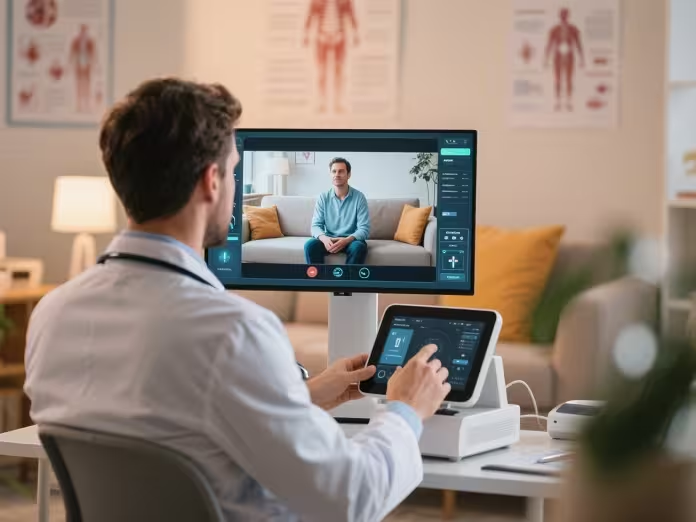
The stethoscope may still hang around doctors’ necks, but the future of healthcare is increasingly digital. What began as an emergency response during the COVID-19 pandemic has evolved into a permanent transformation that’s redefining how we access, receive, and think about medical care. Telemedicine and remote healthcare isn’t just a temporary fix—it’s becoming the new normal, and the implications are staggering.
The Unexpected Catalyst That Changed Everything
When hospitals worldwide faced unprecedented challenges in 2020, telemedicine sebagai bagian dari remote healthcare emerged as more than just a backup plan—it became a lifeline. Patients who once waited weeks for specialist appointments suddenly found themselves consulting with top physicians from their living rooms. What seemed impossible just years ago became not only possible but preferred by millions.
The numbers tell an extraordinary story. Telemedicine usage skyrocketed by over 3,000% during the pandemic’s peak, transforming from a niche service used by less than 1% of patients to a mainstream healthcare delivery method embraced by nearly 40% of Americans. This wasn’t just adoption—it was a complete paradigm shift.
Breaking Down the Barriers That Held Healthcare Back
Traditional healthcare has always been bound by geography, time constraints, and accessibility issues. Telemedicine and remote healthcare shatters these limitations in ways that seemed like science fiction just a decade ago. Rural patients no longer need to drive hours to see specialists. Elderly individuals with mobility issues can receive quality care without leaving home. Working parents can consult pediatricians during lunch breaks instead of taking entire days off.
Consider Sarah, a working mother in rural Montana whose child developed concerning symptoms on a weekend. Before telemedicine or remote healthcare, her options would have been limited to emergency rooms or waiting until Monday for a pediatrician. Instead, she connected with a board-certified physician within minutes, received an accurate diagnosis, and had a prescription sent to her local pharmacy—all while her child remained comfortable at home.
The Technology Behind the Transformation
Modern remote healthcare platforms have evolved far beyond simple video calls. Today’s systems integrate artificial intelligence for preliminary assessments, high-definition cameras for detailed examinations, and secure messaging systems that maintain patient privacy while enabling continuous communication between visits.
Wearable devices now transmit real-time health data directly to healthcare providers, creating a continuous monitoring system that catches problems before they become emergencies. Smart blood pressure cuffs, glucose monitors, and even AI-powered stethoscopes allow patients to provide clinical-grade data from home, enabling physicians to make informed decisions without in-person visits.
The integration of electronic health records with telemedicine platforms creates seamless care coordination. Physicians can access complete patient histories, lab results, and imaging studies during virtual consultations, ensuring that remote care maintains the same quality and continuity as traditional office visits.
Reshaping Healthcare Economics and Accessibility
The financial implications of remote healthcare extend far beyond individual savings. Healthcare systems are discovering that virtual consultations cost significantly less to deliver while often providing better outcomes through increased accessibility and follow-up compliance.
Patients save an average of $100-300 per telemedicine visit when factoring in transportation costs, lost wages, and childcare expenses. For healthcare providers, telemedicine and remote healthcare reduces overhead costs while allowing them to see more patients efficiently. This economic efficiency is particularly crucial as healthcare systems worldwide face increasing pressure to provide quality care while controlling costs.
The accessibility benefits are even more profound. Patients with chronic conditions can maintain regular contact with their healthcare teams, leading to better disease management and fewer emergency interventions. Mental health services, once limited by stigma and geographical constraints, have found new reach through telemedicine platforms, with therapy and psychiatric consultations becoming more accessible than ever before.
Overcoming the Skeptics: Quality and Trust in Virtual Care
Initial concerns about the quality of telemedicine as remote healthcare have been largely dispelled by mounting evidence of its effectiveness. Studies consistently show that patient satisfaction rates for telemedicine consultations match or exceed those of in-person visits, with many patients reporting feeling more comfortable discussing sensitive health issues from the privacy of their homes.
The diagnostic accuracy of telemedicine has also proven remarkably high for many conditions. Dermatology consultations via high-quality imaging show accuracy rates comparable to in-person examinations. Mental health assessments often benefit from the relaxed environment of patients’ homes, leading to more open and honest communication.
Healthcare providers initially skeptical about virtual care have become advocates after experiencing its benefits firsthand. Dr. Jennifer Martinez, a family physician in Texas, noted that telemedicine and remote healthcare allows her to spend more quality time with each patient, free from the time pressures of traditional office scheduling. “I can truly focus on my patients’ concerns without watching the clock,” she explains.
The Future Landscape of Healthcare Delivery
As telemedicine becomes increasingly sophisticated, we’re witnessing the emergence of hybrid care models that combine the best of virtual and in-person medicine. Patients might have initial consultations via telemedicine, followed by in-person visits for procedures or complex examinations, then return to virtual follow-ups for ongoing care management.
Artificial intelligence integration promises to make remote healthcare even more powerful. AI-driven preliminary assessments can help triage patients, ensuring that those who need immediate in-person care are identified quickly while routine concerns are efficiently addressed through virtual consultations.
The expansion into specialized care continues to accelerate. Cardiologists now monitor patients with heart conditions through connected devices, oncologists provide chemotherapy consultations remotely, and surgeons offer pre- and post-operative care through telemedicine platforms. Even emergency medicine is evolving, with “virtual emergency rooms” providing immediate assessment and triage for urgent but non-life-threatening conditions.
Preparing for a Permanently Changed Healthcare Landscape
The transformation to telemedicine and remote healthcare as the new normal requires both technological infrastructure and cultural adaptation. Healthcare systems are investing heavily in secure, user-friendly platforms while training staff to deliver excellent virtual care experiences.
Patients are adapting remarkably well, with older adults—initially the most hesitant demographic—now among telemedicine’s most enthusiastic users. The convenience and reduced exposure to illness in healthcare facilities have made telemedicine particularly attractive to vulnerable populations.
Looking ahead, the integration of remote healthcare into standard medical practice appears irreversible. What began as an emergency measure has proven its value so thoroughly that returning to purely traditional healthcare delivery models seems not just unlikely but counterproductive.
The healthcare revolution is here, and telemedicine or remote healthcare isn’t just part of it—it’s leading it. As technology continues to advance and acceptance grows, we’re not just witnessing a temporary shift but the permanent transformation of healthcare delivery for generations to come. The new normal isn’t coming—it’s already here, and it’s changing lives one virtual consultation at a time.



































